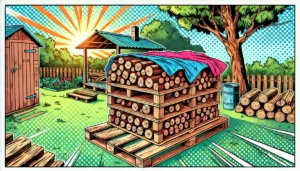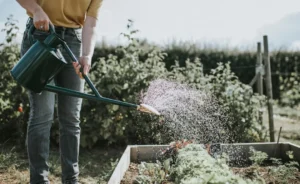Cut your heating bill with free local firewood — legally collected and guilt-free.
Table of contents
🔥 Quick Tip: Ask Tree Surgeons After a Storm
After storms, arborists often have too much wood to deal with — some will even deliver it for free!
Introduction: Find Firewood Near You with Ease
Tired of Sky-High Heating Bills? Get Local Firewood for Free (or Close To It)
Finding affordable firewood in the UK isn’t always easy — but it doesn’t have to be expensive. Whether you’re heating your home, fuelling your firepit, or stocking up for winter, there are plenty of legal ways to source logs locally (and often for free).
To help you save money and reduce waste, we’ve built a tool that shows you where to find firewood near you — with tips for collecting it safely and responsibly.
👉 Jump to the Firewood Finder Tool ↓
Where to Get Free Firewood Near You in the UK
If you’re on the hunt for free firewood near me, you’re not alone. With heating costs rising and sustainability becoming more essential, more people are turning to local and low-cost sources for fuel.
Here are some reliable ways to find firewood near you:
- Facebook Marketplace & Local Groups – Search “free firewood near me” or “free logs” and filter by your postcode. Many people list leftover wood from tree work or renovations.
- Freecycle & Freegle – These networks often have free pallets, timber offcuts, or even full tree trunks available to collect.
- Tree Surgeons & Arborists – Contact local professionals and ask if they have offcuts or felled wood they’re happy to give away.
- Local Council Recycling Centres – Some tips allow you to take discarded wood home, especially if it’s untreated.
- Woodland Management & Farms – Some landowners are open to you collecting wood in exchange for clearing it or tidying brush.
The Firewood Finder Tool
Ready to find wood for burning near you? Use our Firewood Finder Tool to search for local free logs from tree surgeons, arborists, or stores selling kiln dried firewood in your area. (Works Worldwide)
How it Works
Finding logs near you has never been easier. Whether you’re looking for free firewood near me or affordable options, our tool has you covered. The Firewood Finder Tool delivers real-time, localized results, connecting you with free fire logs from local arborists or premium kiln-dried logs from trusted stores.
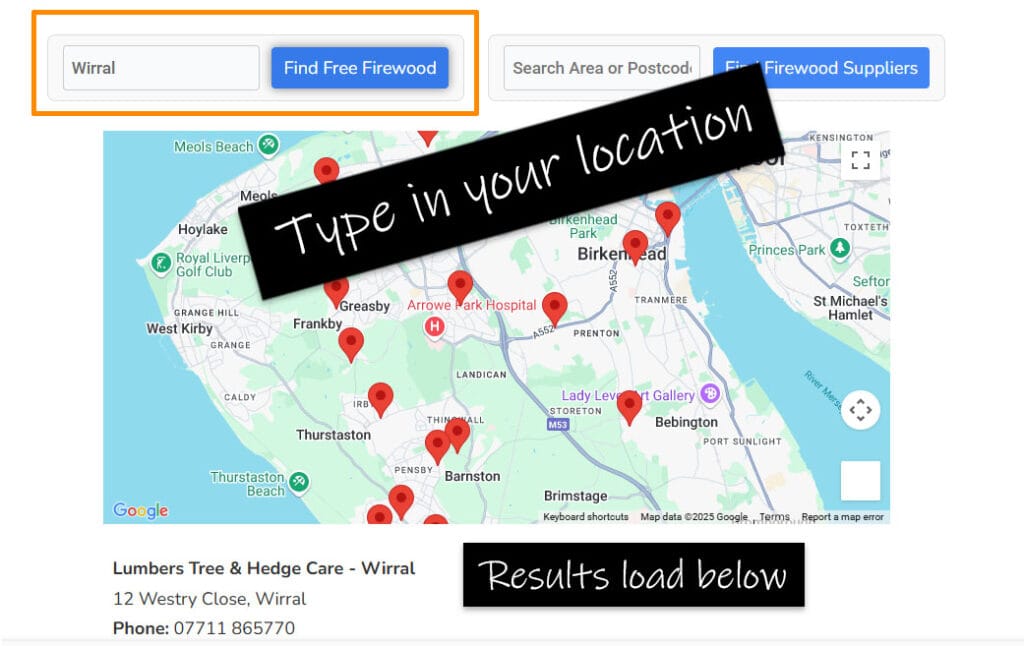
Step-by-Step Guide
- Choose Your Search Type: Use wither “Free Firewood” to find tree surgeons and arborists offering free firewood near me.
- Enter Your Location: Type your town, city, or postcode (or Zip Code) into the search box. (Post Code or Zip Code works best!)
- View Your Results: Instantly see a list of timber providers tailored to your area. (Under the map)
- Contact a Provider: Reach out directly to arrange pickup, delivery, or to get more details about the firewood they offer.
💡 Tip: Try searching by both your postcode and nearby towns to see more results — some providers list by town name instead of postcodes.
💬 Tip: When contacting people, always ask if the wood is seasoned or green, and whether it’s safe for burning indoors or in a garden incinerator.
Why Use the Firewood Finder Tool?
- Save Time: Avoid the hassle of searching across multiple websites or platforms.
- Get Reliable Results: Connect with trusted tree surgeons, arborists, and fire logs suppliers.
- Enjoy Flexibility: Whether you need free or affordable Kiln-dried logs, the tool adapts to suit your specific needs.
- Localized Searches: Find fire logs based on your exact location, ensuring you connect with the best logs near me quickly and easily.
- Search Option:
- Free Firewood: Perfect for those looking for surplus wood at no cost.
- Real-Time Updates: Get the latest information on fire wood availability from local providers.
Where to Buy Cheap Firewood Near You
Can’t find anything free nearby? No problem — there are plenty of ways to buy cheap firewood near you without paying premium prices.
Here are some go-to options:
- Gumtree: Great for one-off log bundles or leftover firewood. Set alerts by postcode.
- Facebook Marketplace: Search for “firewood,” “logs,” or “wood offcuts” — many people list part-used bags after camping or garden work.
- Builders Merchants & Local Yards: Often sell firewood cheaper than large garden centres or supermarkets.
- Farm Shops & Small Garden Centres: Look for off-season deals or bulk discounts.
- Petrol Stations (in rural areas): Some offer firewood bags competitively priced, especially in colder months.
💬 Pro tip: Compare by volume — price per cubic metre or per sack is a better measure than per bag.
Top 5 Places to Find Free Logs Near You
If you’re specifically searching for free logs near me, there are some surprisingly good options if you know where to look:
- Facebook Groups & Marketplace – Join local community pages and search for “free logs” or “firewood.” People often give away wood after garden jobs.
- Council Recycling Sites – Some green waste centres allow public collection of untreated logs or tree limbs.
- Tree Surgeons – Local arborists often have log rounds or offcuts available — just ask!
- Freegle & Freecycle UK – These platforms are goldmines for firewood, pallets, and other usable offcuts.
- Allotment Boards & Farm Entrances – Rural properties often leave signs offering free wood after hedge cuts or storm clean-ups.
💬 Tip: Bring gloves and check wood types — hardwoods burn longer and cleaner than softwoods.
Benefits of Using the Firewood Finder Tool
Our Firewood Finder Tool is here to make sourcing free wood easy, efficient, and stress-free. Check out the key benefits you’ll enjoy:
1. Instant Results
- Quickly find local firewood providers, whether you’re looking for free firewood near me or fire logs.
- Get real-time, accurate results tailored to your location so you can act fast.
2. Save Time and Effort
- Forget browsing multiple websites or reaching out to countless providers. The tool brings everything together in one place, simplifying your search for firewood near me.
- Focus on what matters most—getting the logs you need quickly and without hassle.
3. Flexible Options
- Choose between free firewood near me from tree surgeons or arboristsf or affordable options.
- With the search function, you’ll easily find the type of free wood that suits your needs.
4. Trusted Providers
- Connect with verified tree surgeons, arborists, and reputable fire logs suppliers near you.
- Feel confident knowing you’re sourcing firewood from professionals you can trust.
5. Cost-Effective Solutions
- Save money by finding free firewood near me or competitively priced seasoned and kiln-dried logs.
- Cut down on transportation costs by sourcing fire logs locally, keeping it affordable and convenient.
6. Eco-Friendly Benefits
- Using local wood reduces the carbon footprint tied to long-distance transport.
- Support sustainable practices by repurposing surplus wood that might otherwise go to waste.
When you use the Firewood Finder Tool, you’re saving time, cutting costs, and supporting your local community. Plus, you’re making environmentally conscious choices that benefit everyone.
Real Example: One of our readers in Cornwall used the Firewood Finder Tool and connected with a local arborist offering seasoned oak logs — completely free. They had logs ready for pickup the same day!
For essential legal and safety tips to ensure responsible fire logs collection, check out our detailed guide: Legal and Safety Tips for Collecting Firewood.
🔥 6 Best Ways to Find Free Firewood Near You
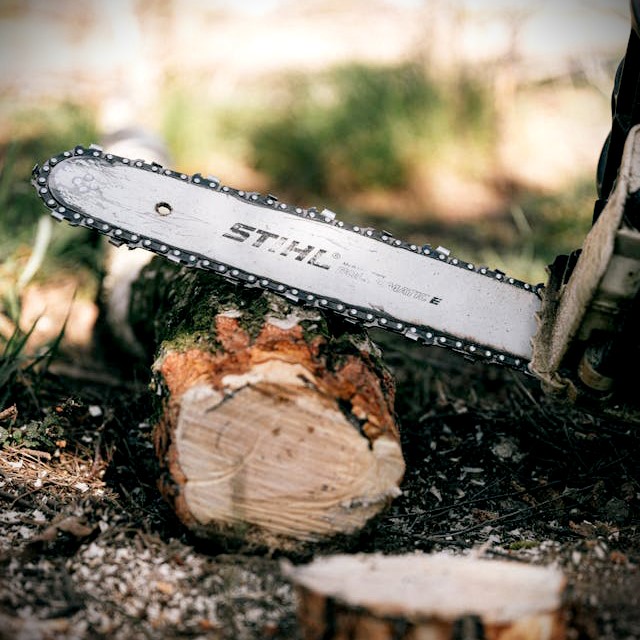
1. Use Local Arborists and Tree Surgeons
Arborists and tree surgeons regularly remove branches, limbs, and entire trees. Many are happy to give away firewood for free, especially if you collect it yourself.
👉 Tip: Ask after storms — they often have surplus wood they want gone quickly.
Best For: Getting freshly cut logs and offcuts from regular tree work.
🔗 Read more: Why arborists are the best source for free firewood
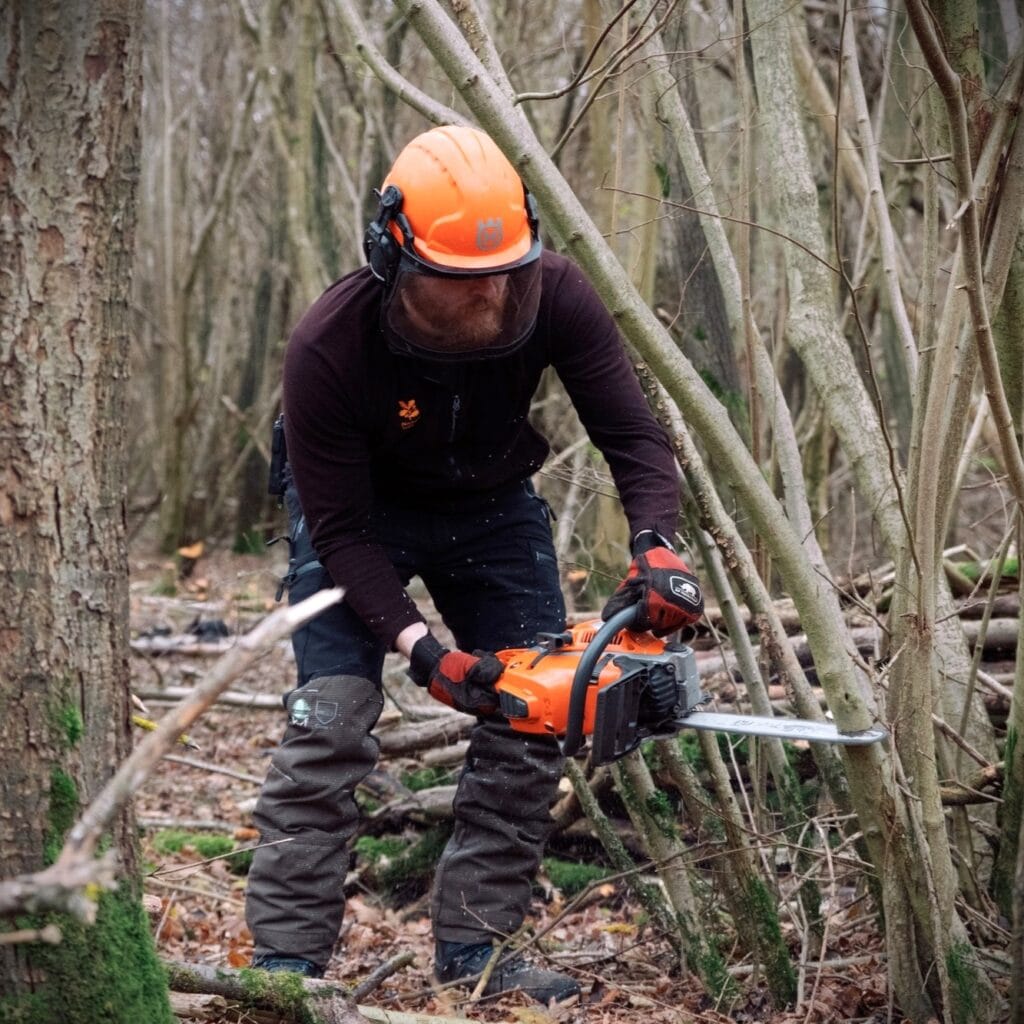
2. Check Council Tree Works and Maintenance Crews
Local councils often prune or remove trees as part of park and street maintenance. Contact your local authority and ask if they allow residents to collect wood.
Some even advertise free logs after large jobs.
Best For: Collecting wood waste like chopped logs, branches, and discarded pallets from official council tips or recycling points.
Watch for: Access limits — some centres require ID, permits, or time-restricted access.
🔗 Related reading: Where to find free pallets near you
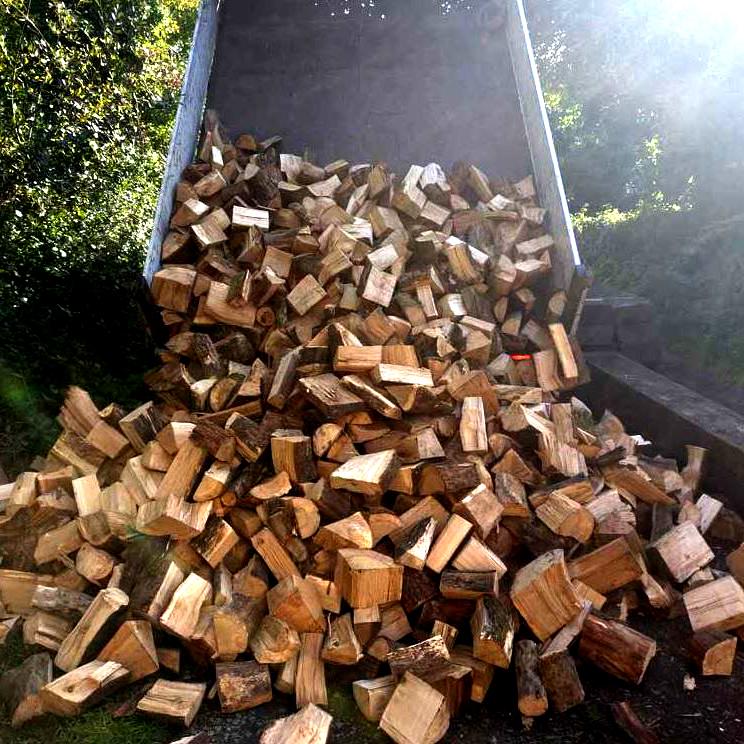
3. Visit Local Firewood Shops for Offcuts
Even though these shops sell wood, they often have bins of offcuts, broken logs, or end pieces available at reduced prices — or free if you ask.
Best For: Finding local giveaways of firewood, old timber, broken furniture, and construction offcuts.
Pro Tip: Set up saved searches and turn on alerts for “logs,” “firewood,” and “pallets” in your area.
🔗 Related reading: Best places to find free wood in the UK

4. Browse Online Free Listings (Facebook, Gumtree, Freecycle)
Many people give away logs and offcuts when clearing their gardens. Check:
- Gumtree > Free Stuff
- Facebook Marketplace
- Freecycle and local forums
Set up alerts so you can grab listings quickly.
🔍 Best For: Free giveaways or trades on unwanted timber, old furniture, and pallets.
✅ Pro Tip: Set up keyword alerts and check early in the day.
🔗 Related reading: Best places to find free wood in the UK
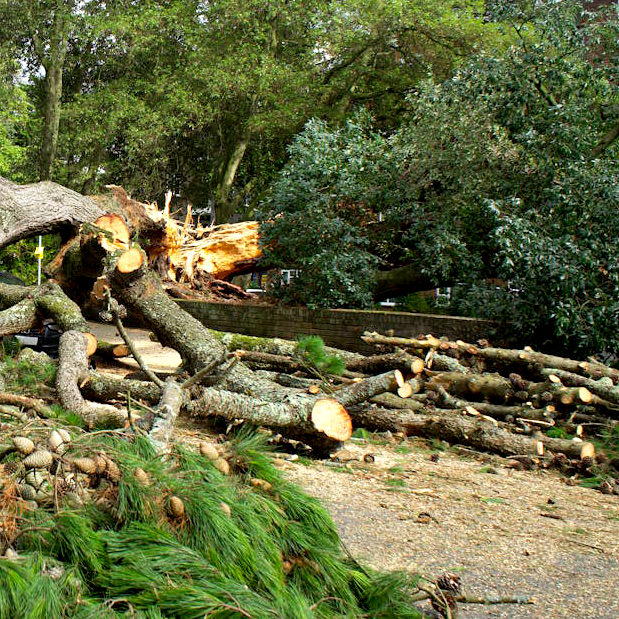
5. Collect Windfall or Fallen Branches (Legally!)
After strong winds or storms, you’ll often find large branches or trees blown down on public land or roadsides.
✅ Only collect from public land where it’s permitted. Avoid nature reserves or protected areas.
6. Ask Around Locally — Word of Mouth Works
Neighbors, friends, or local allotment groups are often clearing land or chopping trees.
Let people know you’re happy to collect free wood — you’d be surprised how often it turns up.
🌱 Bonus Tip: Choose Local Logs for Eco-Friendly Fuel
Using locally sourced logs helps reduce the carbon footprint of delivery and supports your local economy. Plus, it often means less treated wood and more natural offcuts.
💡 Want to Find Firewood Fast?
Use our Free Firewood Finder Tool to locate arborists, shops, and providers near you in seconds.
🔍 Launch the Tool
Why Arborists Are the Best Source for Free Firewood
When it comes to finding free wood, arborists and tree surgeons are the most reliable and sustainable source. Here’s why:
1. Regular Surplus Wood
Arborists frequently remove trees or prune large branches as part of their work, making them an ideal source for free firewood near me. This process often leaves them with surplus wood they need to dispose of. Instead of letting this wood go to waste, many arborists are happy to offer it for free to anyone willing to collect it.
2. Variety of Wood Types
From hardwoods like oak and maple to softwoods like pine, arborists handle a wide range of tree species. This variety means you can find wood that matches your specific needs, whether you want long-burning logs or quick-starting kindling.
3. Eco-Friendly Option
Using surplus wood from arborists reduces waste and promotes sustainable practices. It’s an eco-friendly way to source firewood near me because, instead of being chipped, burned, or sent to landfills, the wood is repurposed as firewood—a cost-effective and environmentally friendly option.
4. Accessibility
Arborists are usually local, meaning the wood they offer is nearby. This ensures quick access to logs near me without the need for extensive transportation. By sourcing locally, you save time and reduce costs while keeping things convenient.
5. Requires Seasoning
While wood from arborists is free, it’s often green (freshly cut) and needs seasoning to burn efficiently. Seasoning involves drying the wood to lower its moisture content, which typically takes 6-12 months depending on the type of wood. Properly seasoned wood burns hotter, cleaner, and more efficiently.
Learn more about the best techniques for seasoning and storing firewood properly by visiting our detailed guide on firewood preparation.

Arbor 6ft Wooden Log Store
Keep your firewood dry, tidy, and seasoned with this spacious, pressure-treated log store.
Perfect for anyone collecting or buying firewood in bulk.
- ✅ Made from pressure-treated timber for durability
- 💨 Ventilated slatted back and base to help seasoning
- 🧱 Large capacity: holds a serious amount of logs
- 🛠️ Comes flat-packed with clear assembly instructions
Key Advantage
Arborists provide the only true source of free wood, combining cost savings with environmental benefits. By connecting with a local tree surgeon, you’re not just getting fire logs; you’re also supporting sustainable resource use while cutting down on heating costs.
Ready to find free firewood near me from local arborists? Use our Firewood Finder Tool to get started today!
Why Use Local Logs?
Choosing local fire logs isn’t just about convenience—it’s about making environmentally friendly and cost-effective choices. Learn about the best techniques for seasoning and storing firewood by visiting our detailed guide on how to season and store firewood.
Here are the top reasons why sourcing free wood locally is the best option:
1. Reduces Your Carbon Footprint
Transporting Kiln-dried logs over long distances requires a lot of energy, adding to greenhouse gas emissions and increasing the environmental cost of heating your home. Using local firewood significantly reduces transportation impacts, helping you support a more sustainable and eco-friendly lifestyle.
2. Prevents the Spread of Pests and Diseases
Moving logs from one region to another can spread invasive pests like the emerald ash borer or harmful tree diseases, which can devastate local ecosystems. By sourcing fire logs locally, you help protect nearby forests and the environment.
3. Supports the Local Economy
Buying Kiln-dried logs from local suppliers keeps money within your community, supporting small businesses, tree surgeons, and firewood stores. It’s a win-win for you and your neighbors.
4. More Affordable Options
Local wood eliminates costly transportation fees, making it more budget-friendly. Nearby tree surgeons and arborists often offer free or low-cost wood, helping you save even more.
5. Easily Accessible
Sourcing local firewood ensures quicker and easier access. Whether you’re collecting free firewood near me from a tree surgeon or purchasing kiln-dried logs, choosing nearby options means less hassle and faster results.
6. Eco-Friendly Benefits
Local logs minimizes waste by repurposing surplus wood from arborists that might otherwise be discarded. This practice prevents unnecessary deforestation and promotes sustainability.
✅ Need the right gear to process your free firewood? Check out our guide to the essential tools for cutting, splitting, and transporting firewood — from axes to wheelbarrows, we’ve got you covered.
🌍 Why Local Firewood Matters — The Stats Behind It
🔥 1. Air Miles & Transport Emissions
🚛 Imported firewood can travel over 1,000 miles before reaching UK homes — driving up emissions and cost.
(Source: Forestry Commission UK)
💷 3. Cost Comparison
💰 Locally sourced or free logs can save households over £300–£500 per year on heating.
(Source: Energy Saving Trust estimate for wood-burning users)
🔥4. Moisture Content Efficiency
💧 Seasoned local hardwood burns 25% more efficiently than store-bought softwood or unseasoned wood.
(Source: HETAS-approved stove installer data)
FAQs
The Firewood Finder Tool is a simple, easy-to-use platform that helps you locate firewood near me, including free or affordable options. It connects you with local tree surgeons, arborists, and log suppliers nearby.
Just enter your location, pick either “Free Firewood” to find free firewood near me or “Firewood Stores” for premium options, and view real-time, localized results. You can then contact providers directly to arrange collection or delivery.
Absolutely! The tool connects you with local arborists and tree surgeons offering surplus wood at no cost.
If you’re getting free wood from arborists, it’s usually green wood that needs seasoning for 6-12 months. Seasoning dries the wood and ensures it burns efficiently and cleanly.
Yes! The “Firewood Stores” search helps you find suppliers offering kiln-dried or seasoned logs that are ready to burn right away.
Yes, it’s completely free to use. The tool is designed to make finding wood for burning simple and accessible for everyone.
The tool gives you real-time, localized results based on your input. It connects you with reliable providers nearby, so you’ll always get up-to-date listings.
Yes, the tool works for both urban and rural areas, helping you find firewood no matter where you live.
You can find a variety of wood types, including hardwoods like oak and ash, softwoods like pine, and logs tailored to your needs.
Each listing includes contact details for the supplier, so you can reach out directly to arrange pickup or delivery.
Yes, many log stores listed in the tool offer bulk delivery options. Check with the supplier for availability and pricing.
Yes, but always follow safety practices when collecting firewood. Wear proper gear and verify the wood’s condition to make sure it’s safe to burn.
Yes — but only with permission. Never take wood from private land or parks without consent. However, many homeowners, businesses, and councils are happy to give it away. Always ask first and avoid protected woodland or nature reserves.
Start online — local Facebook groups, Freegle, and Gumtree are great for free listings. Also, talk to your neighbours or tree surgeons, and visit your council’s waste site to check their policies. Keep a pair of gloves in the boot and stay ready for local pickups!
Local listings like Facebook and Gumtree often have great deals — especially from people clearing out logs after garden work. Also check smaller farm shops, petrol stations, or builder’s yards for better prices than big-box stores.
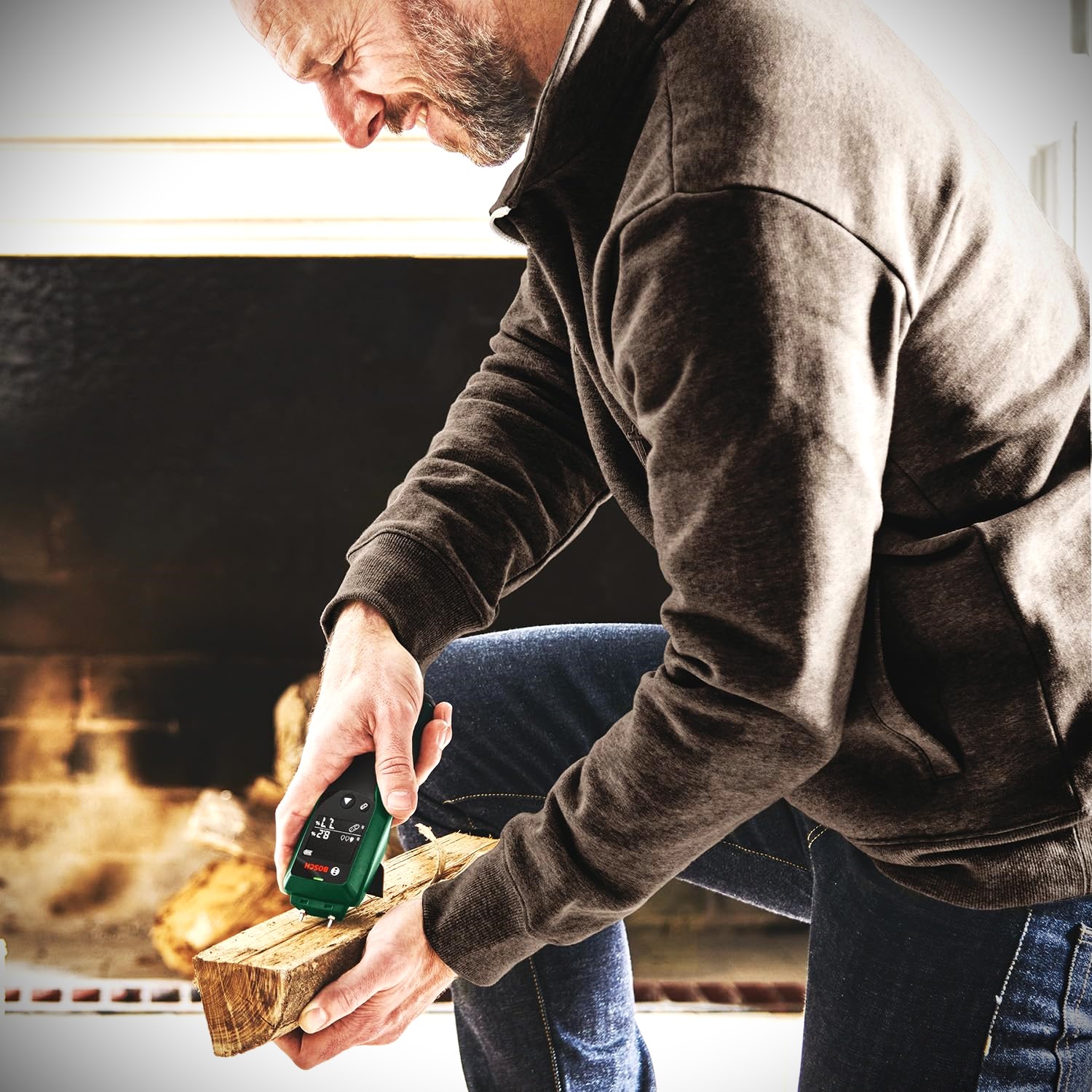
🔎 Bosch Moisture Meter
Take the guesswork out of seasoning firewood. This high-quality Bosch moisture meter gives fast, reliable readings to help you burn clean and efficiently.
- ♻️ Eco-friendly packaging: Shipped in a recyclable cardboard box
- ✅ Fast & accurate: LED traffic light lets you know instantly if your wood is ready
- 🪵 Perfect for firewood: Avoid smokey burns and get more heat
- 🔋 Comes ready to use: Includes batteries, wrist strap & Bosch case
Learn about the best tools for cutting, splitting, and transporting firewood in our comprehensive guide here.
Conclusion
Finding affordable or free firewood doesn’t have to be a hassle. With our Firewood Finder Tool, you can quickly and easily connect with trusted local suppliers and arborists to get the firewood you need.
Whether you’re searching for free firewood near me from tree surgeons or premium kiln-dried logs ready to burn, this tool takes the stress out of finding the best options near you. Plus, by choosing local logs, you’re not just saving money—you’re also reducing your environmental impact and supporting your community.
Key Benefits Recap:
- Save time: Instantly access real-time results customized for your location.
- Save money: Find free firewood near me or affordable options from reliable local suppliers.
- Support sustainability: Help reduce waste and cut down on emissions by sourcing firewood locally.



